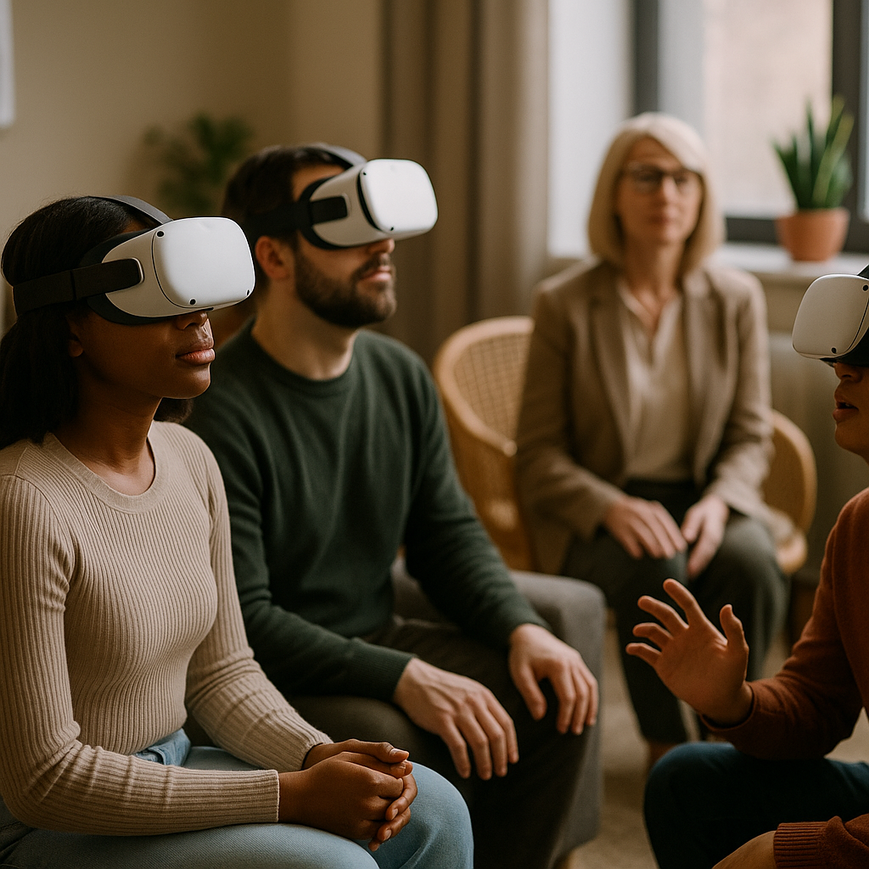
Virtual Reality Therapy: A New Frontier In Mental Health Treatment
“`html
Introduction to Virtual Reality Therapy
Virtual reality (VR) therapy is an innovative approach integrating immersive technology into mental health treatment, gaining traction in recent years. By utilizing VR, therapists can create controlled, virtual environments that simulate real-world scenarios, enabling patients to confront and work through their fears in a safe setting. This technology has shown promise in treating conditions such as anxiety disorders, PTSD, and phobias, offering a unique avenue for exposure therapy and cognitive behavioral approaches Source: National Institutes of Health.
The emergence of VR therapy aligns with the growing recognition of the importance of technology in healthcare, particularly mental health care. Studies suggest that VR can enhance patient engagement, increase the therapeutic alliance, and provide real-time feedback, ultimately leading to improved treatment outcomes Source: Frontiers in Psychology. Additionally, the reduction of stigma associated with mental health treatment facilitated by technology use may further encourage individuals to seek help Source: Psychology Today.
How Virtual Reality Therapy Works
Virtual Reality (VR) therapy utilizes immersive virtual environments to address various mental health conditions such as anxiety, PTSD, and phobias. The practice involves several key techniques and mechanisms:
- Exposure Therapy: VR therapy often incorporates principles of exposure therapy, where patients are gradually exposed to feared stimuli in a controlled environment. For instance, someone with social anxiety might engage in virtual social situations that mimic real-life interactions, enabling them to confront their fears safely.
- Simulated Real-Life Scenarios: VR environments can recreate specific scenarios related to a patient’s trauma or anxiety. For example, a war veteran with PTSD may experience a replay of combat situations in a safe, therapeutic control setting, helping them process their emotions and memories.
- Cognitive Behavioral Therapy (CBT) Integration: VR therapy can be integrated with CBT techniques to help patients reframe negative thought patterns while interacting with the virtual world. This dual approach enhances emotional regulation and cognitive restructuring.
- Mindfulness and Relaxation Techniques: Some VR applications guide users through mindfulness exercises, promoting relaxation and reducing anxiety by immersing them in calming virtual environments, such as serene nature scenes Source: Mindfulness Techniques.
- Real-Time Feedback and Data Tracking: Advanced VR systems often include feedback mechanisms that monitor physiological responses, such as heart rate, giving therapists real-time data on the patient’s stress levels.
- Accessibility and Engagement: VR therapy offers an engaging alternative to traditional therapeutic settings, making it more accessible, especially for individuals who may avoid conventional therapy due to stigma or discomfort.
Studies indicate that VR therapy can lead to significant improvements in symptoms for many mental health conditions, showing promise as an effective complement to traditional therapy approaches.
Benefits of Virtual Reality in Mental Health Treatment
Virtual reality (VR) technology is increasingly being utilized in mental health treatment, offering numerous advantages that enhance traditional therapeutic methods. One significant benefit is the provision of immersive experiences, allowing patients to engage in environments tailored to their specific therapeutic needs. This can heighten emotional responses and facilitate deeper exploration of personal issues in a safe space.
Additionally, VR enables therapists to create controlled settings that simulate various scenarios, helping patients confront fears or practice coping strategies. For instance, exposure therapy for conditions like PTSD or phobias can be effectively conducted in VR, where patients face distressing stimuli in a controlled manner, thereby acquiring skills to manage their anxiety Source: National Institutes of Health.
Enhanced patient engagement is another key advantage. VR experiences can be more engaging than traditional therapy methods, capturing patients’ attention and encouraging participation Source: Frontiers in Psychology. Moreover, VR provides instant feedback to both patients and therapists, allowing for real-time adjustments and personalized therapy strategies, demystifying mental health treatment and reducing stigma Source: American Psychological Association.
Challenges and Limitations of VR Therapy
Virtual reality (VR) therapy is a promising field but faces several substantial challenges that hinder its broader adoption. Accessibility remains a significant barrier; despite advancements in VR technology, high costs can limit availability to specialized clinics or those with substantial resources Source: American Psychological Association.
Cost is another critical obstacle. The financial burden of VR systems includes not just the upfront costs of the equipment but also ongoing expenses such as software subscriptions and maintenance, which can deter institutions from incorporating VR therapy Source: Frontiers in Psychology.
Technological constraints also pose challenges, including the need for high-quality hardware and user-friendly applications. Many existing VR environments can induce motion sickness or disorientation, limiting usability Source: National Institutes of Health. These challenges emphasize the need for continued innovation and investment in VR therapy.
The Future of Virtual Reality Therapy
Virtual reality (VR) therapy is rapidly evolving and stands at the crossroads of technology and mental health care. Its integration into mainstream healthcare is promising, with projections indicating significant growth over the next decade. Research published in *Frontiers in Psychology* states that VR therapy can enhance exposure therapy by immersing patients in controlled environments Source: Frontiers in Psychology.
Studies highlight a notable rise in clinician-initiated pilot studies and clinical trials exploring VR therapy’s efficacy, aided by increasing recognition of its potential to address varied mental health issues Source: JMIR. The accessibility of consumer-grade VR headsets further facilitates its adoption in therapeutic settings Source: NIH.
Ongoing research continues to shape the future of VR therapy, with academic institutions and tech companies collaborating to develop sophisticated applications that enhance patient experience. Advancements exploring biometrics and biofeedback mechanisms aim to optimize therapeutic outcomes Source: ScienceDirect.
Sources
- American Psychological Association – Virtual Reality Therapy: An Overview
- American Psychological Association – Assessment of Virtual Reality in Therapy
- Frontiers in Psychology – The Many Benefits of VR Therapy
- Frontiers in Psychology – Challenges Encountered in VR Therapy
- Frontiers in Psychology – The Efficacy of Virtual Reality Therapy
- JMIR – The Growth of VR Therapy in Healthcare
- National Institutes of Health – VR Therapy and its Impact on PTSD
- National Institutes of Health – Understanding Virtual Reality Therapy
- NIH – Consumer-Grade VR Technology and Mental Health
- National Institutes of Health – Technological Constraints in VR Therapy
- Psychology Today – The Rise of Virtual Reality Therapy
- ScienceDirect – Future Directions in VR Therapy
- Mindfulness Techniques – A Guide to Finding Peace
“`








